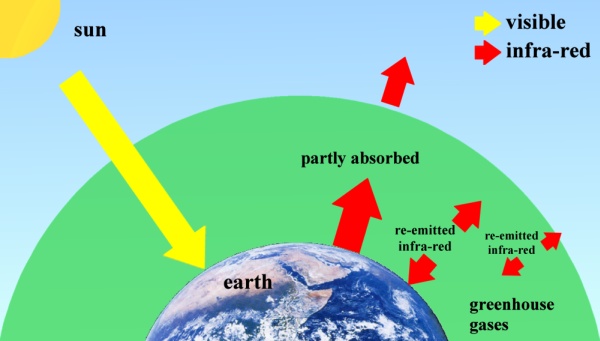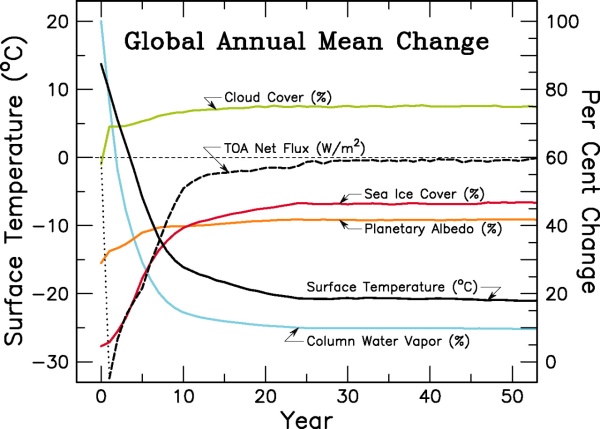Who's in charge of global warming?
25 July 2013
There has been an argument to dismiss concerns about the rising emission of carbon dioxide (CO2), saying that the most important greenhouse gas is water vapour which is much more abundant than CO2 in the atmosphere and more powerful than CO2 in absorbing infrared radiation. However, the scientific fact is that CO2 is ranked number one of the factors contributing to the Earth's warming climate. To understand why CO2, instead of water vapour, controls Earth's temperature, we have to look at the properties of these two greenhouse gases.
Water vapour is condensable with a short residence time of about a week to ten days in the atmosphere. Its concentration in the atmosphere depends on air temperature: a warmer (cooler) atmosphere can hold more (less) water vapour. Hence most of the water vapour concentrate in the lower troposphere as temperature generally decreases with increasing altitude in the troposphere[1].
On the other hand, CO2 is a well-mixed greenhouse gas with a long residence time of centuries in the atmosphere. It is most abundant among the non-condensable greenhouse gases. Compared to water vapour, CO2's significance in preventing energy from escaping from the Earth grows as one looks higher up in the atmosphere. Imagine that the infrared radiation emitted by Earth's surface is absorbed and re-emitted in random directions by greenhouse gases in the layer of air above ground, the upward-going radiation will then be absorbed and re-emitted by greenhouse gases in another layer of air higher up (Figure 1). As the altitude increases, the air gets thinner, colder and drier. In other words, less and less water vapour exists and exerts its greenhouse effect as one goes up in the atmosphere, while CO2 is still doing its job as it is a well-mixed and non-condensable greenhouse gas. Furthermore, water vapour and CO2 absorb infrared radiation at different wavelengths. Some infrared radiation may be able to slip through water vapour but will be intercepted by CO2. Therefore, it is CO2 instead of water vapour serving as the final "goalkeeper", preventing heat from escaping to the space.
Then what is the role of water vapour in global warming? As water vapour is also a greenhouse gas, its presence in the atmosphere can also help raise the Earth's temperature. However, from our latest knowledge from climate science, water vapour is playing just a supporting role. After the temperature of the atmosphere has been elevated due to the presence of other greenhouse gases, it can hold more water vapour which will then further enhance the greenhouse effect. It was estimated that water vapour could amplify the greenhouse effect caused by CO2 in the atmosphere by approximately a factor of two. At the same time, it should be noted that things can also work in an opposite direction: a cooler atmosphere will have a lower water vapour holding capacity, thus any excessive amount of water vapour will then condense and its greenhouse effect will consequentially decrease.
The dominance of non-condensable greenhouse gases like CO2 in sustaining the greenhouse effect can be illustrated by a simulation experiment conducted a few years ago by the scientists at NASA using an advanced climate model[2]. Once they removed all the non-condensable greenhouse gases from the climate model, simulation result shows that the surface temperature would plunge below - 15 oC in ten years and the amount of water vapour in the atmosphere will be substantially reduced by about ninety percent (Figure 2). It is clear from this experiment that CO2 is the principal control knob of Earth's temperature.
S M Lee, H W Tong
References:
[1] en.wikipedia.org/wiki/Troposphere
[2] Atmospheric CO2: Principal Control Knob Governing Earth's Temperature. Andrew A. Lacis, et al. Science 330, 356 (2010); DOI: 10.1126/science.1190653.

Figure 1Greenhouse effect.

Figure 2Time evolution of global surface temperature (black line, scale on left axis)
and water vapour (light blue, scale on right axis) after all non-condensable
greenhouse gases are removed from the climate model simulation (From
Atmospheric CO2: Principal Control Knob Governing Earth's Temperature.
Andrew A. Lacis, et al. Science 330, 356 (2010); DOI: 10.1126/science.1190653.
Reprinted with permission from The American Association for the Advancement
of Science. Readers may view, browse, and/or download material for temporary
copying purposes only, provided these uses are for noncommercial personal
purposes. Except as provided by law, this material may not be further reproduced,
distributed, transmitted, modified, adapted, performed, displayed, published,
or sold in whole or part, without prior written permission from the publisher.)
Water vapour is condensable with a short residence time of about a week to ten days in the atmosphere. Its concentration in the atmosphere depends on air temperature: a warmer (cooler) atmosphere can hold more (less) water vapour. Hence most of the water vapour concentrate in the lower troposphere as temperature generally decreases with increasing altitude in the troposphere[1].
On the other hand, CO2 is a well-mixed greenhouse gas with a long residence time of centuries in the atmosphere. It is most abundant among the non-condensable greenhouse gases. Compared to water vapour, CO2's significance in preventing energy from escaping from the Earth grows as one looks higher up in the atmosphere. Imagine that the infrared radiation emitted by Earth's surface is absorbed and re-emitted in random directions by greenhouse gases in the layer of air above ground, the upward-going radiation will then be absorbed and re-emitted by greenhouse gases in another layer of air higher up (Figure 1). As the altitude increases, the air gets thinner, colder and drier. In other words, less and less water vapour exists and exerts its greenhouse effect as one goes up in the atmosphere, while CO2 is still doing its job as it is a well-mixed and non-condensable greenhouse gas. Furthermore, water vapour and CO2 absorb infrared radiation at different wavelengths. Some infrared radiation may be able to slip through water vapour but will be intercepted by CO2. Therefore, it is CO2 instead of water vapour serving as the final "goalkeeper", preventing heat from escaping to the space.
Then what is the role of water vapour in global warming? As water vapour is also a greenhouse gas, its presence in the atmosphere can also help raise the Earth's temperature. However, from our latest knowledge from climate science, water vapour is playing just a supporting role. After the temperature of the atmosphere has been elevated due to the presence of other greenhouse gases, it can hold more water vapour which will then further enhance the greenhouse effect. It was estimated that water vapour could amplify the greenhouse effect caused by CO2 in the atmosphere by approximately a factor of two. At the same time, it should be noted that things can also work in an opposite direction: a cooler atmosphere will have a lower water vapour holding capacity, thus any excessive amount of water vapour will then condense and its greenhouse effect will consequentially decrease.
The dominance of non-condensable greenhouse gases like CO2 in sustaining the greenhouse effect can be illustrated by a simulation experiment conducted a few years ago by the scientists at NASA using an advanced climate model[2]. Once they removed all the non-condensable greenhouse gases from the climate model, simulation result shows that the surface temperature would plunge below - 15 oC in ten years and the amount of water vapour in the atmosphere will be substantially reduced by about ninety percent (Figure 2). It is clear from this experiment that CO2 is the principal control knob of Earth's temperature.
S M Lee, H W Tong
References:
[1] en.wikipedia.org/wiki/Troposphere
[2] Atmospheric CO2: Principal Control Knob Governing Earth's Temperature. Andrew A. Lacis, et al. Science 330, 356 (2010); DOI: 10.1126/science.1190653.

Figure 1Greenhouse effect.

Figure 2Time evolution of global surface temperature (black line, scale on left axis)
and water vapour (light blue, scale on right axis) after all non-condensable
greenhouse gases are removed from the climate model simulation (From
Atmospheric CO2: Principal Control Knob Governing Earth's Temperature.
Andrew A. Lacis, et al. Science 330, 356 (2010); DOI: 10.1126/science.1190653.
Reprinted with permission from The American Association for the Advancement
of Science. Readers may view, browse, and/or download material for temporary
copying purposes only, provided these uses are for noncommercial personal
purposes. Except as provided by law, this material may not be further reproduced,
distributed, transmitted, modified, adapted, performed, displayed, published,
or sold in whole or part, without prior written permission from the publisher.)